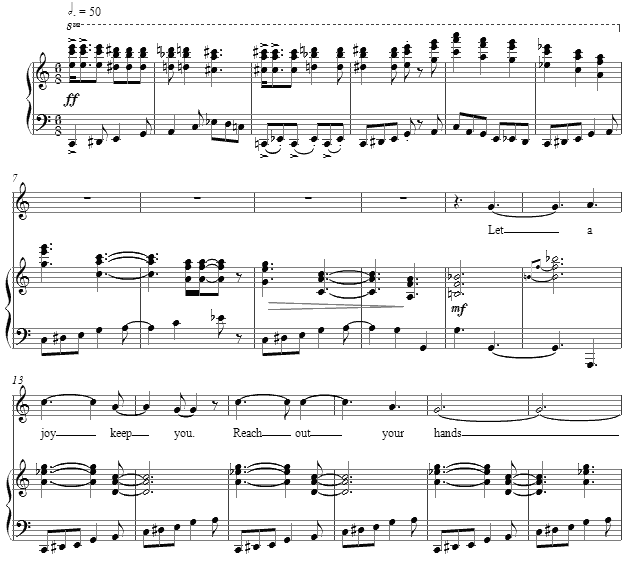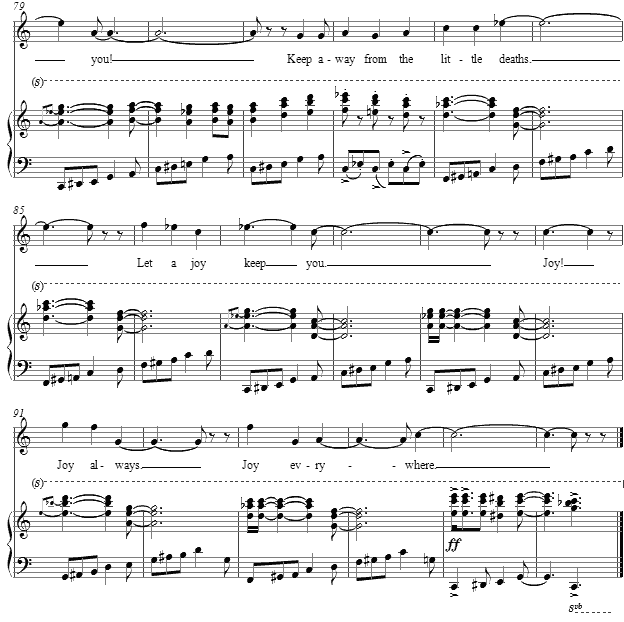Music and Texts of GARY BACHLUND
Vocal Music | Piano | Organ | Chamber Music | Orchestral | Articles and Commentary | Poems and Stories | Miscellany | FAQs
Joy - (2009)
Carl Sandburg
for high voice and piano
for Anna Sylvan
Let a joy keep you.
Reach out your hands
And take it when it runs by,
As the Apache dancer
Clutches his woman.
I have seen them
Live long and laugh loud,
Sent on singing, singing,
Smashed to the heart
Under the ribs
With a terrible love.
Joy always,
Joy everywhere--
Let joy kill you!
Keep away from the little deaths.
[ 4 pages, circa 2' 00" ]
Carl Sandburg
Sandburg speaks to us of a zest for living, in comparing the joy he so clearly recommends to "the Apache dancer" who "clutches his woman." This is a most visceral image, for the Apache dancer, either man or woman, took part in a dance-pretense of some brutality. The pantomime dance tells of the pimp -- Apache in the French of the 1910s as made popular by Maurice Mouvet -- accosting his prostitute. As she refuses to turn over her earnings to him, and he slaps her, throws her around, and drags her by her hair in circles of triple time meter and finally and leaves her as in a heap in the corner. She crawls back, begging forgiveness, professing love. The name is taken from a Parisian street gang, which styled itself as vicious in the perceived manner of an American Indian tribe. The word, apache, however is pronounced in regard to the dance in the French manner of two syllables.
This of course violates modern feminist sensitivities, for which one need remind that the dance is a pantomime just as plays about abuse and murder are simply theater. Without such reminders of life, no Medea could be staged, no Otello sung, and no grim realities of life portrayed in any similar fashion in a humorless and artless life. Sandburg's suggestion is not so much that art imitates life and such brutality is to be emulated, as the intensity which a life such as the Apache dance suggests is pained large on a canvas. So should joy be, even if sometime darkly received or dimly seen.
The text is drawn from Sandburg's 1916 anthology, Chicago Poems. For more on other of my Sandburg settings, please see his entry in Authors' Alphabetical Index - S.
The Scotch snap of the opening and the emphasis on the tonic accent in general allows the hemiola in a 6/8 a larger effect, and highlights the aggressiveness with which Sandburg paints the notion of "joy." Therefore the opening is marked fortissimo. The verses into which this non-rhyming poem's sentences are structured are built around references to blues gestures, though an actual blues form is avoided.
The coda after three verses reiterates the poet's advice that we find joy "always" and "everywhere." The last verse places the right hand an octave higher, suggesting the honky tonk saloon wherein one might see such a dance to life, even one so darkly represented as in the Apache dance. Rubati and a general emphatic ritardando towards the final cadence may be interpolated by the performers as felt, but are not wholly necessary.
Anna Sylvan
Dr. Anna Sylvan was born in Indiana, but grew up in New York und Arizona. At fifteen she played Beethoven's Piano Concerto No. 1 with orchestra and won various competitions. During her study at Mills College in California) she began to study voice as well. At the University of Arizona she earned her degrees of Master of Arts und Doctor of Musical Arts. She taught voice and choral conducting at the University of Texas El Paso, while performing opera roles such as Cherubino, Orlovsky, Hänsel und Rosina in regional opera theaters. In 1989 Sylvan moved to Mainz, where she sang both as solo and chorus. She lived in Berlin and led the children's choruses at the Deutschen Staatsoper and choruses of various Berlin schools, and also worked as vocal coach and instructor for piano, voice and recorder.
The score for Joy is available as a free PDF download, though any major commercial performance or recording of the work is prohibited without prior arrangement with the composer. Click on the graphic below for this piano-vocal score.



